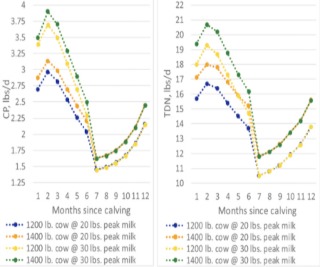Calving season has started or is quickly approaching for most producers. While the focus has been on getting the cows to calving, shifting focus to post-calving nutrition is critical. Nutrition post-calving is important, as cows are at their greatest nutrient demands to support lactation and repair the reproductive tract (see the article, Beef Cow Nutrition During Calving and Early Lactation to learn more).
First-Calvers
First-calvers often require more attention following calving. They require more labor and higher-quality feeds; however, by investing the time in these young cows, they often stay in the herd longer and are productive cows. The smaller size of bred heifers or a three-year-old cow compared to mature cows means that she is less able to compete with the older cows for feed resources. Therefore, the energy needs of these young females are not met, and they lose body condition from the time of calving to breeding season, which can lead to poor reproductive performance. This is often why it is suggested that the younger cows should be managed and fed separately from the mature cows before and after calving.
HOW DO FIRST-CALVERS DIFFER FROM MATURE COWS AT THE SAME STAGE OF GESTATION OR LACTATION?
In fact, they are not much different at all; however, the percent of the diet that needs to be protein or energy is different among both groups. To meet requirements, first-calf heifers should be supplemented or fed diets ~10 to 15% more protein and energy per unit of body weight than the diets fed to mature cows.

Cows with their first calf will make less milk than older cows, but nutrient requirements are still greater because they are still growing.
Remember it is important to provide high-quality forages to the first-calvers. Having a proper feeding plan will help to maintain adequate body condition or provide needed weight gain.
Use caution if feeding excessive amounts of nutrients before or after calving. Overfeeding protein during the breeding season and early gestation may lead to decreased fertility. The combination of high levels of degradable protein and low energy concentrations in early-season grasses could contribute to lower fertility rates in females placed on those pastures near breeding time. As always, be sure to follow a good vitamin and mineral program and ensure fresh water is always available to the herd.
Source :